Samsung SyncMaster T200 20in LCD Monitor Review
Samsung SyncMaster T200 20in LCD Monitor
As if a 10,000:1 contrast ratio wasn't enough, Samsung comes along and doubles it.
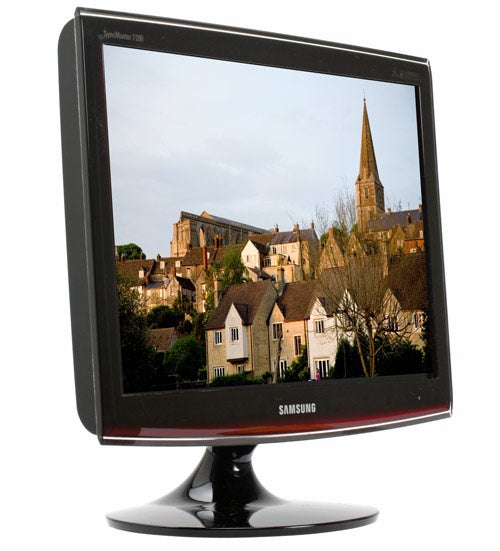
Verdict
Key Specifications
- Review Price: £196.52
Taste is very much a personal thing, as popular machines like the Asus Eee PC 901 and Inspiron 1525 (sequel to the impressive Dell Inspiron 1520) prove by being customisable in a large range of colours – I’ll have pink please. But seriously, apart from shape, colour is one of the more important factors that has influenced design throughout the ages. The most gorgeously-shaped object can be ruined, for example, by a sickly-green matte finish. Conversely even a brick of a machine can be made more attractive by a glossy black coating, or something a little more creative.
In the technology market, certain ‘in’ colours tend to dominate, and in the past few years most ‘cool’ gear has come in black, silver or combinations of the two. Doubtlessly inspired by TrustedReviews, orange seems to be on the rise – especially in the gaming sector – and can be found in everything from Asus’ XG station to Acer’s new Predator Gaming PC. Like black though, red is a colour that never seems to lose its appeal, being the de-facto colour of Ferraris. And though some dislike it for being too in-your-face and garish, those are certainly not accusations that can be levelled at Samsung’s latest “Touch of Colour” (ToC) range of designer televisions and monitors, with their subtle hint of red swirled into a black chassis.
Today we’re looking at the cheapest way to get a touch of colour into your home, the 20in SyncMaster T200 monitor, which can be had for around £200. Its crystal “black rose” design is not the only thing up its red-tinged sleeve, however, as Samsung doubles the already far-fetched contrast ratio of the LG Flatron W2252TQ with a claimed figure of 20,000:1. What’s even more unlikely is that this would give it a better contrast rating than Samsung’s own LE32A656 TOC 32in LCD TV. But apart from that, we have the expected specifications for a 20in monitor, with the usual 1,680 x 1,050 resolution and 2ms response time.
Unlike most previous Samsung monitors, which came in two parts, the T200 actually comes in five. First of course we have the display itself, with a back-plate that you click in to hide the connectors once all cables are attached. Then comes a stand in two parts, which once set-up looks remarkably similar to the one on the SyncMaster Pebble 2232BW – but thankfully eschews that model’s nightmarish ‘ball-hinge’ for a simple click-in system. Finally there is a tidy little cable clip, which cannot be attached to the monitor but can keep up to four cables together and out of the way.
After the flimsy-feeling Samsung 225uw, it’s also a relief to find the T200 not lacking in solidity, with none of the creaking that marred the 225uw in evidence. Connectivity-wise, there’s nothing out of the ordinary, with one HDCP-enabled DVI and an analogue VGA port, with cables provided for both. Unfortunately, adjustability is limited to tilt, a trend that many monitor manufacturers have employed on their budget displays. Sure, it makes a monitor cheaper to manufacture and potentially better looking, but the simple fact is that for many users (including myself) it will sit either too high or too low on the desk, which in turn will cause ergonomic discomfort. Not to mention pivot being very handy when reading long pages in word or on the web.
Of course, much as with the BenQ V2400W, the highlight of this monitor is supposed to be its design, but at first glance I was mildly disappointed, since having seen Samsung’s “touch of colour” implementation in its LCD televisions (like the gorgeous Samsung LE46A656 46in LCD TV), I was expecting more, well, red. The main difference being that, where the televisions had strong lines of red in both the upper and lower parts of the bezel, the T-series monitors only feature one towards the bottom. But never fear, there are still subtle hints of red everywhere that the frame meets the panel, and the slightest trace on the surround’s external edge.
Though the stand is just the common glossy piano-black finish, the bezel on the T200 is given added depth by an extra layer of clear plastic, which extends beyond the monitor’s frame to form a clear see-through outer strip. I’m not completely convinced by this aspect, but it certainly shows off the ‘touch of colour’ to its best effect and helps lend the monitor a unique look. As with most Samsung monitors, a decent cleaning cloth is included to keep your display as glossy as when it first arrived.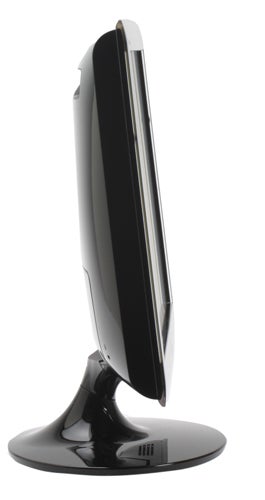
Unfortunately the T200’s response time and contrast ratio join the familiar model number and Samsung logo on the bezel, but at least they’re a light grey colour that doesn’t draw the attention. And the monitor’s clean lines are not broken by buttons or LEDs either: the power switch is an unobtrusive, touch sensitive icon, while the restrained red LED is perfectly integrated with the stripe of colour. In fact, in a well-lit room it can be difficult to see whether this display is turned on when in standby.
In terms of looks the T200 is undeniably attractive, just don’t expect the crystal design to have quite the same impact as it did with Samsung’s televisions. Whether you prefer it to other stylish displays really depends on your personal taste, but if it’s the red (rose black) colour that’s putting you off, you’ll be glad to know that Samsung is intending to add emerald black and sapphire black to the T-range.
The SyncMaster’s controls are actually the simplest I’ve encountered in a while, with just a few niggles. The main one is the power button, which like many other touch-sensitive buttons needs pressure from your full fingertip. Worse is that when turning the monitor on, it takes about five seconds for the screen to actually display an image, and because the LED is barely visible in strong ambient light and there is no other indicator of success, I actually ended up turning the monitor off again thinking I had failed to turn it on in the first place. But once you know, this isn’t a problem.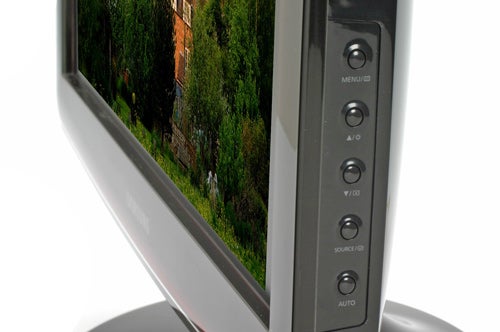
The menu-controls, meanwhile, are physical buttons, and despite being around the right side of the display I only had to look once to use them from then on. This is partially because of their smooth but distinct shapes, and partially due to logical layout. From top to bottom we have menu/back, brightness/up, assignable-function-button/down, source/select and finally auto for analogue configuration. This means that much like on a piano (or in Guitar Hero), you simply place your fingers over the top four buttons by feel, and adjustments are effortless.
The assignable-function-button especially is a masterstroke, and can be dynamically assigned to act as a shortcut to MagicBright, MagicColor, Color Effect or Image Size. It is a feature I’ve long wished to see on all monitors, and I can’t praise Samsung enough for finally making it happen on an entry-level model. Let’s hope other manufacturers follow suite.
The menus themselves should be familiar to previous Samsung users, but now have more options than ever before. Apart from the usual ones such as brightness, contrast gamma and menu-settings, we find a wide range of colour settings. MagicColor can be set to off, Demo, Full and Intelligent. Whether you’ll want to turn it on (and if so, I would recommend the Intelligent setting) depends on if you like your movies bright and vibrant or prefer subtler, more muted tones. Color Tone offers Cool, Normal, Warm and Custom presets, while Color Control speaks for itself, offering RGB adjustments. Color Effect, meanwhile, is reminiscent of the LG Flatron W2252TQ‘s fun function, in that it allows you to make the displayed material greyscale, green, aqua or sepia. I wonder if this is a new trend in budget TN monitors, though despite offering more effects than the LG, Samsung does not mention it anywhere in its press material. 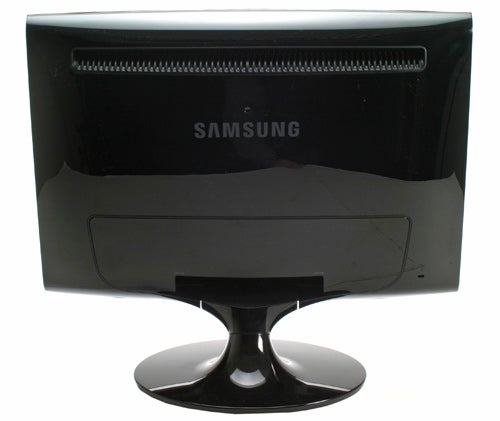
Furthermore, the LED can be switched on or off, and RTA (response time acceleration) can be toggled between three settings. There is also basic aspect ratio control under the name Image Size, where Auto will occasionally stretch the image, but usually offers true 1:1, while Wide just fills the screen (which is helped by excellent interpolation). MagicBright offers the usual presets: Custom, Text, Internet, Game, Sport, Movie and Dynamic Contrast. In this case though, they’re not quite as well configured as might be expected, and you’ll want to avoid Movie mode altogether, as it adds a strong yellow cast.
Unfortunately but not unexpectedly, the T200 doesn’t manage to live up to its claimed 20,000:1 contrast rating. That’s not to say it’s bad, as for a TN-panel it actually does quite well – just don’t expect it to take over from rival LCD technologies, let alone plasma, anytime soon. Dynamic Contrast doesn’t improve things much, but doesn’t cost you any dark detail either, so you might as well leave it on for movies and games, where you will get decent if not good blacks without the loss of detail we see on so many LCDs. This is borne out in our DisplayMate tests, where the SyncMaster T200 showed some of the best TN greyscale results since the wide-gamut Viewsonic VP2250wb.
Viewing angles are also quite good, with one glaring exception: whites can turn to pale yellow when moving your view even slightly off-centre. This immediately rules out the Samsung for any kind of graphics work, which is a pity considering its strengths. In addition to superior greyscale performance, you also get a virtual lack of banding and only the merest hint of dithering. On the other hand, the T200 suffers from backlight bleed from the entire lower edge and towards the centre of the upper border of the screen. 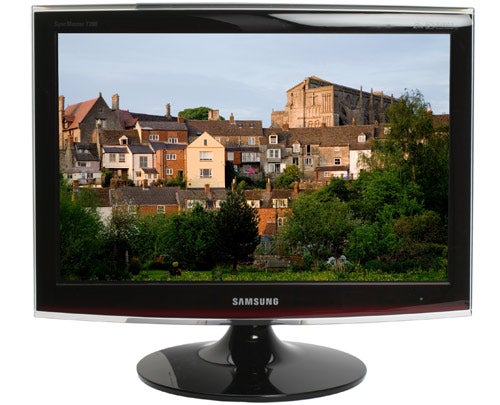
It’s also worth keeping in mind that the T200 produces very little heat and is energy efficient, using 40W maximum and less than 1W in standby. So what we are left with is a monitor that looks great (if you like the design) and has above average image quality for a TN, despite the white-yellow colour shift. However, for around the same money, the HP w2207 offers an extra two inches of screen real-estate (albeit with somewhat inferior image quality), more physical adjustability than you can shake a stick at, and an integrated two-port USB hub, all wrapped up in a good-looking case.
”’Verdict”’
Samsung’s new “Touch of Colour” design might not work quite as well on its T-series monitors as its LCD TVs, but the SyncMaster T200 is very attractive nonetheless. In the stylish casing comes a TN panel that also impressed despite some conspicuous flaws, and as with most designer monitors, adjustability is limited. If you can live with the drawbacks though, the T200 could be just the thing for everyday use, gaming and movies, and just plain looking good.
Trusted Score
Score in detail
-
Image Quality 7
-
Design 8
-
Value 7
-
Features 6

